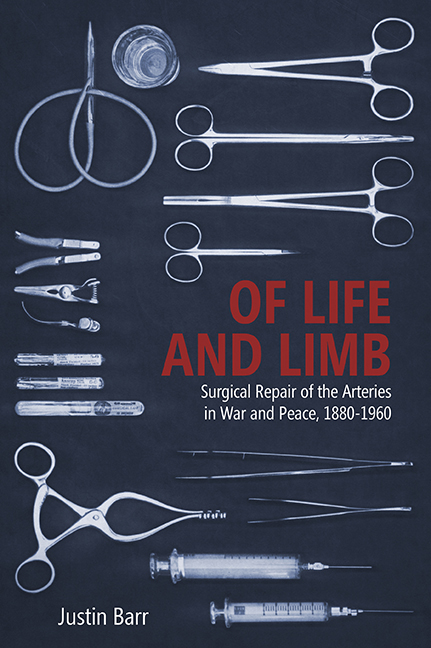 Surgical Repair of the Arteries in War and Peace, 1880–1960
Surgical Repair of the Arteries in War and Peace, 1880–1960 Book contents
- Frontmatter
- Contents
- Acknowledgments
- Introduction
- 1 Technical Change, Practical Stasis: The Development of Arterial Repair through 1914
- 2 An Ideal Rarely Practiced: Arterial Repair and Its Alternatives from World War I to World War II
- 3 Opportunities Realized and Discarded: The Management of Vascular Trauma in World War II
- 4 Reshaping Surgical Infrastructure between World War II and the Korean War
- 5 An Ideal Implemented: Arterial Repair in the Korean War
- 6 Bringing It All Back Home
- Conclusion: Arterial Repair and the Process of Surgical Change
- Notes
- Bibliography
- Index
4 - Reshaping Surgical Infrastructure between World War II and the Korean War
Published online by Cambridge University Press: 29 March 2020
- Frontmatter
- Contents
- Acknowledgments
- Introduction
- 1 Technical Change, Practical Stasis: The Development of Arterial Repair through 1914
- 2 An Ideal Rarely Practiced: Arterial Repair and Its Alternatives from World War I to World War II
- 3 Opportunities Realized and Discarded: The Management of Vascular Trauma in World War II
- 4 Reshaping Surgical Infrastructure between World War II and the Korean War
- 5 An Ideal Implemented: Arterial Repair in the Korean War
- 6 Bringing It All Back Home
- Conclusion: Arterial Repair and the Process of Surgical Change
- Notes
- Bibliography
- Index
Summary
The end of World War II had proven arterial repair both feasible and, in most cases, a superior operation to ligation, but in the postwar years surgeons again returned to tying off blood vessels. With Carrel's technique well established, it required a series of scientific and professional developments to make the practice of vascular anastomosis widespread. In the short time between World War II and the Korean War, there were no technical advances, no neoteric diagnostic technology invented, and no novel instrumentation introduced. Rather, the supporting infrastructure around the practice of vascular surgery changed in four interrelated ways. First, rapid progress in heart surgery sparked additional research on related topics, particularly the preservation and use of blood vessels for grafts. Second, anesthesiology transitioned from a nurse-centric service to a physician-driven specialty that facilitated surgeons safely performing increasingly invasive operations, like those on large blood vessels. Third, the Society for Vascular Surgery, founded in 1947, created the space for the presentation and appreciation of research while fostering a sense of professional community. Finally and most importantly, residencies, which had educated only a select few doctors before the war, graduated into a standardized and ubiquitous route of surgical education, producing a cadre of well-trained operators. These four contextual changes all occurred outside the operating room but nonetheless proved crucial to the eventual adoption of arterial repair by creating a fertile milieu that enabled its rapid, broad use in the Korean War and the years thereafter.
Vascular Surgery Research between World War II and Korea: Cardiac Surgery and Vessel Banks
The paucity of arterial repair in World War II and the resulting high amputation rate following ligation disappointed many young surgeons who returned to the United States determined to establish reparative procedures. Allan Callow, who served as a battalion surgeon in the Pacific and landed on Tarawa with the third assault wave, recalled in a later interview, “Since I saw so many arms, legs, and lives lost in the war [from vascular trauma], I th[ought] 's like to do something with arterial surgery.” Callow and fellow academic surgeons re-demonstrated the efficacy of arterial repair and further refined operative techniques.
- Type
- Chapter
- Information
- Surgical Repair of the Arteries in War and Peace, 1880–1960Surgical Repair of the Arteries in War and Peace, 1880–1960, pp. 92 - 105Publisher: Boydell & BrewerPrint publication year: 2019
